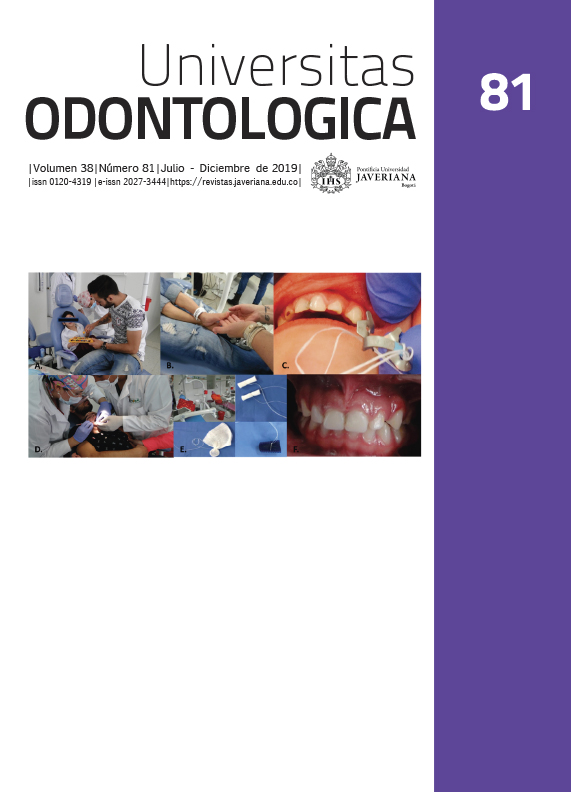Abstract
Background: Fibrous dysplasia and ossifying fibroma are benign pathologies that generally have no painful symptoms, are rare, and affect bone tissue. They produce aesthetic and functional alterations, which is why patients consult. Purpose: To describe the cellular disorders characteristic of fibrous dysplasia and ossifying fibroma, as well as their relationship with clinical forms and other histopathological variables that constitute a challenge for the oral pathologist and the clinician. Description of the cases: Two cases of adult patients, male and female, who attended the Stomatology and Oral Surgery Unit of the University of Cartagena in Colombia, are described. The patients shoed facial, asymptomatic, and unilateral asymmetries that compromised patients’ aesthetics. Clinical, radiographic, and histological characteristics are described. Conclusion: Fibrous dysplasia and ossifying fibroma are similar benign bone disorders that require differential diagnosis in order to establish suitable and specific treatments.
2. Nair S, Kini R, Rao P, Bhandarkar G, Kashyp R, Rai M, Naik N, Santhosh A. Fibrous dysplasia versus juvenile ossifying fibroma: a dilemma. Case Rep Dent. 2016; 643902. https://doi.org/10.1155/2016/6439026
3. Özşen M, Yalçinkaya Ü, Bilgen MS, Yazici Z. Fibrous Dysplasia: Clinicopathologic Presentation of 36 Cases. Turk Patoloji Derg. 2018; 34(3): 234-41. https://doi.org/10.5146/tjpath.2018.01428
4. Seifi S, Foroghi R, Rayyani A, Kiani M, Mohammadi M. Juvenile trabecular ossifying fibroma. A case report. Indian J Surg Oncol. 2018; 9(2): 260-4.
5. Sultan A, Schwartz M, Caccamese J, Papadimitriou J, Basile J, Foss D, Younis R. Juvenile trabecular ossifying fibroma. Head Neck Pathol. 2018; 12(4): 567-71. https://doi.org/10.1007/s12105-017-0862-6
6. Robalino D, Sandoval F, Sandoval R. Reporte de caso clínico. Fibroma osificante juvenil. OdontoInvestigación. 2017; 3(2): 8-16. https://doi.org/10.18272/oi.v3i2.946
7. Bravo R, Gunckel R, Mardones M, Carrasco R, Canto L. Fibroma osificante juvenil trabecular mandibular: presentación de un caso con reconstrucción inmediata mediante un injerto libre de la cresta ilíaca y costocondral. Rev Esp Cir Oral Maxilofac. 2015; 37(1): 38-43. https://doi.org/10.1016/j.maxilo.2013.02.001
8. Tobar L, Carrau R, Valencia M. Presentación clínica y tomográfica de pacientes con displasia fibrosa craneofacial en la Clínica José A. Rivas. Acta Otorrinolaringol Cir Cabeza Cuello. 2018; 40(3): 229-35.
9. Akashi M, Matsuo K, Shigeoka M, Kakei Y, Hasegawa T, Tachibana A, Komori T. A Case series of fibro-osseous lesions of the jaws. Kobe J Med Sci. 2017; 63(3): E73-E79.
10. Serrano A, Molina D, Orenday J, Arriada N. Displasia fibrosa cervicotorácica. Arch Neurocienc. 2017; 22(2): 86-94.
11. Pereira C, Blanco E, Cepero B. Displasia fibrosa monostótica de los maxilares. A propósito de un caso. Medimay. 2018; 25(2): 155-9.
12. Ayala F. Utilización de bifosfonatos en el tratamiento de la displasia fibrosa de los maxilares. Rev Cientif Estud Inv. 2018; 7: 116-7.
This journal is registered under a Creative Commons Attribution 4.0 International Public License. Thus, this work may be reproduced, distributed, and publicly shared in digital format, as long as the names of the authors and Pontificia Universidad Javeriana are acknowledged. Others are allowed to quote, adapt, transform, auto-archive, republish, and create based on this material, for any purpose (even commercial ones), provided the authorship is duly acknowledged, a link to the original work is provided, and it is specified if changes have been made. Pontificia Universidad Javeriana does not hold the rights of published works and the authors are solely responsible for the contents of their works; they keep the moral, intellectual, privacy, and publicity rights.
Approving the intervention of the work (review, copy-editing, translation, layout) and the following outreach, are granted through an use license and not through an assignment of rights. This means the journal and Pontificia Universidad Javeriana cannot be held responsible for any ethical malpractice by the authors. As a consequence of the protection granted by the use license, the journal is not required to publish recantations or modify information already published, unless the errata stems from the editorial management process. Publishing contents in this journal does not generate royalties for contributors.



